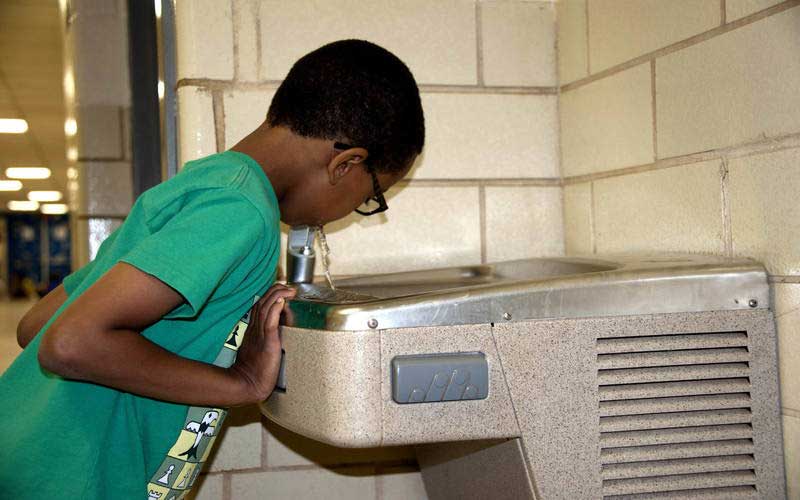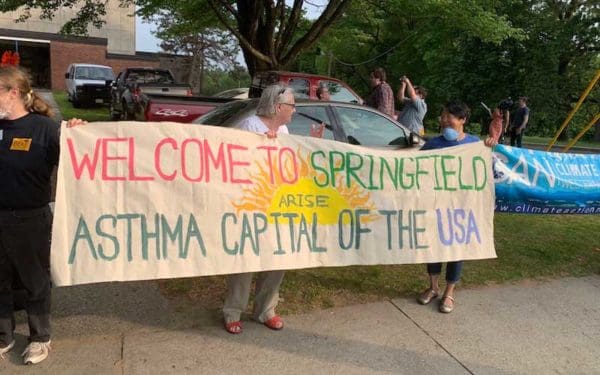
School water fountains and pipes can be hidden source of lead exposure for our kids. We need our schools to test their water – and share the results with parents. Photo: Pixnio
As children throughout New England return to school, thoughts turn to the excitement of our kids meeting new teachers, learning new subjects, and reuniting with friends. In the midst of this annual “new beginning,” however, it’s essential for us all to consider a basic question – does the drinking water at my child’s school contain lead?
It’s a disturbing and unfortunate fact that schools and childcare centers – places where children spend so much time – can have unsafe levels of lead in their water, putting our kids’ health at risk. To ensure safe water, it’s time for parents and teachers to make their voices heard and demand that schools test their water for lead and take measures necessary to protect the health of schoolchildren.
No level of lead exposure is safe for our kids. Together, we can make a difference and protect our children from the lifelong harms of lead poisoning.
Lead in Water Can Happen Here, Too
While deteriorating lead-based paint is considered the most significant source of lead exposure for kids, the ongoing tragedy in Flint, Michigan, is a grim reminder that lead also can be present in drinking water. In fact, the Environmental Protection Agency (EPA) has estimated that 10 to 20 percent of human exposure to lead may come from the water we drink.
As more policymakers are recognizing, it’s critical to address lead in drinking water in the places where kids congregate – schools and childcare centers. In Massachusetts alone, of more than 800 schools tested last year, a staggering 69 percent recorded lead levels higher than the Environmental Protection Agency’s 15 parts per billion standard set out in its Lead and Copper Rule. I’ll discuss this in greater detail below, but this is not a health-based standard and far exceeds the standard recommended by the American Academy of Pediatrics and the State of Vermont. In Massachusetts alone, in schools with water exceeding 15 parts per billion, more than 10 percent recorded levels 33 times greater than the Lead and Copper Rule’s standard.
Lead Can Be Found in School Drinking Water Fountains and Plumbing
It’s hard to believe in 2018, but not all water fountains are lead-safe. This is especially true in older schools, as the American Academy of Pediatrics has explained. EPA has actually identified water fountains that contain tanks lined with lead or other lead components.
Even if a school’s water fountains are safe, lead may still be a problem. That’s because it can be found in the service lines, pipes, and solder that are part of a building’s plumbing system.
Some states, such as New Hampshire and Rhode Island, have mandated testing for lead in schools and childcare centers. Other states, like Vermont, Maine, and Massachusetts, strongly encourage (but do not mandate) schools to test for lead.
Proactively addressing the issue of lead in drinking water is the only way we can know for sure that our schools and childcare centers are providing safe water. We need our schools to:
- Check if any of the lead-containing water fountains on EPA’s list are present in school buildings and, if any are, immediately replace them with lead-safe fountains.
- Test water at all points of consumption – including all water fountains and any taps used for drinking water or food preparation – to determine whether lead is present in the plumbing system and posing a health risk. And then they need to share the test results with parents.
How much lead is too much lead?
No level of lead exposure is safe, and even low levels can cause significant health problems for children.
That’s why EPA has established a goal of zero parts per billion (ppb) lead in drinking water.
Unfortunately, despite its stated goal of zero, EPA has not established a health-based standard for lead in drinking water. Rather, the only federal lead standard is part of EPA’s so-called Lead and Copper Rule. This rule requires that, 10 percent or more of samples from taps across a community are found to have a lead concentration of 15 parts per billion (or higher), the public water system must take anti-corrosion measures to reduce the leaching of lead.
To be clear, the Lead and Copper Rule’s 15 parts-per-billion standard is an administrative tool used by EPA to assess overall public water systems. It is not a health-based standard (although it’s sometimes incorrectly assumed to be).
The American Academy of Pediatrics recommends that state and local governments “take steps to ensure that water fountains in schools do not exceed water lead concentrations of 1 [part per billion].” Acknowledging that there is no safe level of lead, Vermont’s Health Department has established a health advisory of 1 part per billion and is encouraging schools to take action “to ensure lead levels in drinking water are as low as possible.”
Consistent with the American Academy of Pediatrics, Vermont’s health advisory, and the standard recommended in legislation considered (but not passed) in Massachusetts this year, schools should take immediate action if they find lead at a level higher than 1 part per billion in their water.
Parents can make a difference
When it comes to the risk of lead in drinking water, regardless of what various state laws may or may not require schools to do, parents can provide a critical voice in ensuring safe water for our kids.
Specifically, parents can help by calling or writing their school’s administrator and:
- Asking whether any lead-containing water fountains on EPA’s list are present and, if any are, insisting on their immediate removal;
- Asking for any recent lead testing results, and, if water has not been tested, requesting that it be done immediately and the results shared with parents; and
- Urging action to eliminate the presence of lead from any water fountain or tap testing at a level higher than 1 part per billion.
CLF is reaching out to school board associations and others across the region, urging action to protect our kids from lead in drinking water. If parents reach out to their schools as well, we can all make a difference in ensuring healthy, bright futures for our children.



